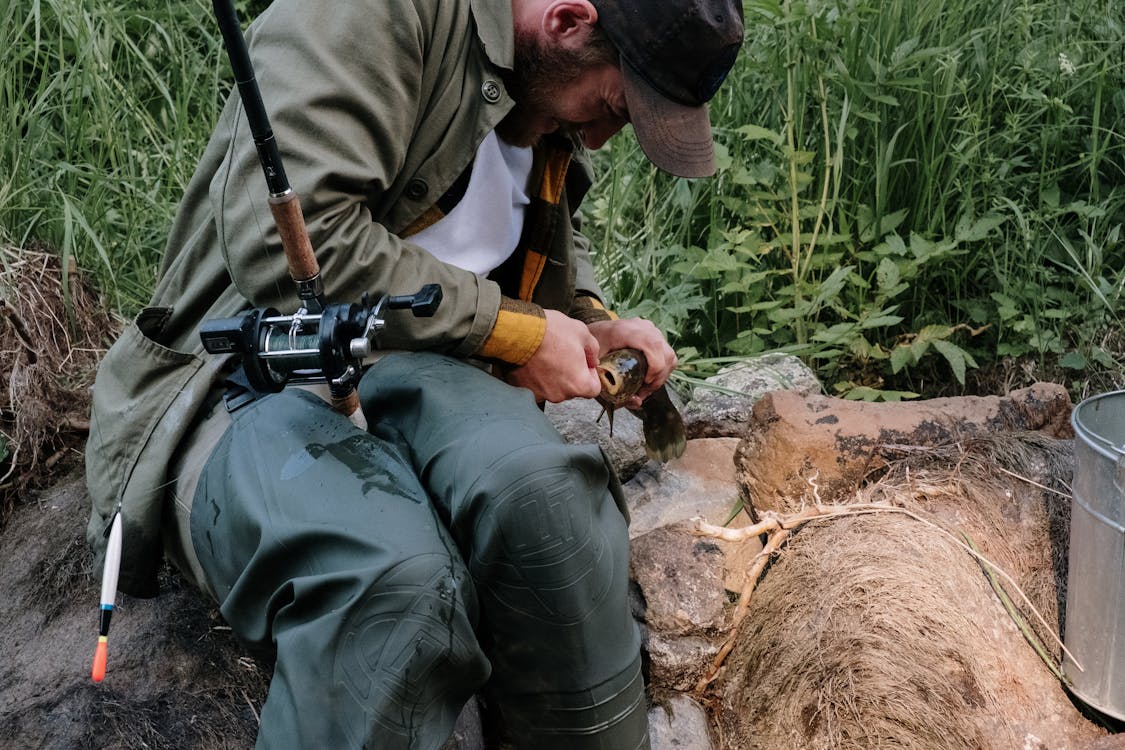
If you're tired of fishing the same lakes and ponds, it’s time to explore some of the most unusual places to catch bass.
Imagine fishing in the misty lochs of the Scottish Highlands or the vast, untamed waters of the Mekong River.
These spots not only challenge your angling skills but also immerse you in stunning landscapes and rich cultures.
In this guide, we will take you to some of the most unusual places to reel in bass.
So without further ado, let’s explore the first spot.
1. West Palm Beach, Florida
West Palm Beach is home to some of the most exciting bass fishing opportunities in Florida.
The interconnected waterways, lush wetlands, and hidden canals create the perfect environment for largemouth bass.
Unlike traditional lakes, these swampy areas require a strategic approach to tackle the thick vegetation and unpredictable water depths.
If you're planning a fishing trip here, make sure to check out this source for more details on the best spots and tips to maximize your success.
Best Spots to Fish in West Palm Beach
- Lake Osborne: Known for its healthy bass population and diverse underwater structure. The mix of deep and shallow areas makes it ideal for year-round fishing.
- Grassy Waters Preserve: A vast, shallow marsh that provides plenty of cover for bass, especially during early mornings and late evenings.
- Canals and Backwaters: Don’t overlook the winding canals; they often hold monster bass hiding beneath overhanging vegetation and submerged logs.
Challenges of Fishing in Swampy Conditions
The dense aquatic plants in swampy conditions can easily snag your lures, and sudden water level changes can make navigation tricky.
Look for clear pockets within the vegetation and use weedless lures to improve your chances of landing a catch.
2. Lake Baikal, Russia
Lake Baikal, the deepest freshwater lake in the world, presents a unique challenge for bass anglers willing to brave its icy waters.
With its crystal-clear depths and extreme temperatures, fishing here requires specialized techniques and gear to handle the cold environment.
Fishing Conditions and What to Expect
The frigid waters of Baikal remain below freezing for most of the year, making ice fishing a popular method.
However, during the short summer months, bass becomes more active in the shallower areas, often found near rocky outcrops and submerged structures.
Top Fishing Techniques for Cold Waters
- Slow Retrievals: Bass in cold water are less aggressive, so slow-moving lures like jigs and jerk baits tend to work best.
- Depth Targeting: During winter, bass tend to stay deeper, while in warmer months, they can be found closer to the surface.
Preparing for Baikal’s Harsh Environment
Dressing appropriately is crucial. Insulated waterproof gear, layered clothing, and specialized gloves help combat the bone-chilling cold while allowing you to stay on the water longer.
3. Pantanal, Brazil
The Pantanal, the world’s largest tropical wetland, offers a fishing experience unlike any other.
With its labyrinth of slow-moving rivers, flooded grasslands, and diverse aquatic life, it’s a paradise for bass anglers looking for an adventure in the heart of South America.
Understanding the Pantanal’s Ecosystem
Unlike conventional lakes, the Pantanal features fluctuating water levels that change with the seasons.
Bass here thrives in submerged forests and flooded meadows, often lurking near the roots of aquatic plants.
Best Times to Fish in the Pantanal
- Dry Season (May - October): Water levels recede, making it easier to spot bass and navigate through the channels.
- Wet Season (November - April): Fish spread out, making it challenging but rewarding for those willing to search deeper into the floodplain.
Challenges You Might Face
The sheer size of the Pantanal can be overwhelming.
Hiring a local guide can make a big difference, helping you locate the best fishing spots and avoid areas with dangerous wildlife such as caimans and anacondas.
4. Lake Tanganyika, Africa
Lake Tanganyika, stretching across four African countries, is one of the oldest and deepest lakes in the world.
Its crystal-clear waters and diverse ecosystem provide an extraordinary bass fishing opportunity for those willing to explore its depths.
Where to Find Bass in Tanganyika
Bass in Lake Tanganyika often inhabits rocky shorelines, submerged ledges, and deeper underwater caves.
Early mornings and late evenings are the most productive times, as bass become more active when the sun isn’t as intense.
Effective Fishing Strategies for Deep Waters
- Vertical Jigging: This technique works well for deeper areas where bass stays during the day.
- Live Bait: Small native fish like sardines can attract larger bass lurking in the depths.
- Deep Diving Crankbaits: Essential for covering large areas efficiently and reaching deeper fish.
Fishing Challenges and How to Overcome Them
The lake's vastness can be daunting. Using GPS tracking and depth finders can help pinpoint productive fishing zones.
Additionally, sudden weather changes are common, so it's important to stay updated on local conditions.
5. The Mekong River, Southeast Asia
The Mekong River, stretching across six countries, offers not only an exciting bass fishing experience but also a glimpse into the vibrant cultures along its banks.
This mighty river, with its murky waters and rich biodiversity, presents unique challenges that require both patience and adaptability.
Prime Fishing Locations Along the Mekong
- Tonlé Sap Lake, Cambodia: A seasonal fishing hotspot where water levels fluctuate dramatically, bringing bass into shallow feeding grounds.
- Chiang Rai, Thailand: Offers a mix of slow-moving and fast currents, ideal for finding bass sheltering near submerged logs and river bends.
- Mekong Delta, Vietnam: A vast network of tributaries and floating markets, making it a great spot for fishing amidst the daily hustle of local life.
Best Techniques for River Fishing
Bass often position themselves near structures such as overhanging trees, undercut banks, and floating vegetation.
For this reason, using live bait, such as small local fish, can significantly increase your chances in these nutrient-rich waters where bass prefer natural prey.
Challenges of Fishing in the Mekong
The river’s unpredictability—due to seasonal floods and heavy boat traffic—demands flexibility.
It's crucial to stay informed about local conditions and be prepared for sudden changes in water clarity and depth.
Hiring a local guide can make a huge difference in navigating the complex waterways.
6. Kamchatka Peninsula, Russia
Kamchatka, known for its untouched wilderness and volcanic landscapes, offers a one-of-a-kind bass fishing adventure.
The region’s remote rivers and lakes are home to some of the fiercest bass you’ll encounter, thriving in the pristine, mineral-rich waters.
Top Fishing Spots in Kamchatka
- Kronotsky Lake: Surrounded by volcanic peaks, this deep, cold lake is teeming with large bass hiding beneath submerged lava formations.
- Bystraya River: A fast-moving river that challenges anglers with strong currents and rocky obstacles.
- Kuril Lake: Rich in aquatic life, this lake offers excellent opportunities for both fly fishing and spin casting.
What Makes Kamchatka Unique for Bass Fishing
The combination of glacial meltwater and volcanic minerals creates a nutrient-rich environment that supports rapid fish growth.
Bass in Kamchatka are known for their aggressive strikes and powerful fights, making every catch an adrenaline-filled experience.
Pro Tip: Use bright-colored lures to stand out in the crystal-clear waters and attract more attention from deeper areas.
Challenges and Considerations
Kamchatka’s remote location means limited access to supplies and long travel times.
Plan ahead by bringing all necessary gear and preparing for extreme weather conditions, from sudden snowfall to unexpected rain showers.
7. Tasmanian Wilderness, Australia
Tasmania’s rugged landscape and isolated lakes provide an untouched bass fishing haven.
The clear, tannin-stained waters are full of surprises, from lurking bass beneath fallen trees to sudden temperature drops that can change fish behavior in an instant.
Where to Fish in Tasmania
- Lake St Clair: The deepest freshwater lake in Australia, offering a mix of deep and shallow fishing opportunities.
- Arthur River: A wild, remote river with thick forested banks that make for excellent bass cover.
- Derwent River Estuary: Where freshwater meets saltwater, creating a dynamic fishing environment.
Adapting to Tasmania’s Unique Conditions
Tasmania’s ever-changing weather requires anglers to be adaptable.
Windy conditions can push bass into protected coves, while calm, overcast days make them more likely to venture into open water.
Wildlife Encounters and Safety Precautions
Fishing in the Tasmanian wilderness means sharing the waters with local wildlife, including platypuses and freshwater eels.
Always stay aware of your surroundings and pack insect repellent, as mosquitoes can be relentless near the water’s edge.
8. Okavango Delta, Botswana
The Okavango Delta, a vast inland river system teeming with wildlife, offers a surreal bass fishing experience.
This UNESCO World Heritage site transforms with the seasons, creating endless opportunities to explore new fishing grounds amid a stunning landscape of papyrus-lined channels and crystal-clear lagoons.
Key Fishing Hotspots in the Delta
- Chief’s Island: A prime fishing area with abundant bass hiding beneath the thick vegetation.
- Moremi Game Reserve: Provides access to secluded fishing spots where the waters are virtually untouched.
- Xakanaka Lagoon: A deeper, more open water area with large bass patrolling submerged reed beds.
Mastering the Delta’s Fishing Challenges
With fluctuating water levels and dense vegetation, anglers must use stealth and precision when casting.
The key to success lies in finding deeper channels where bass seeks refuge from the sun during the hot African afternoons.
Pro Tip: Use surface lures early in the morning when bass are more active in the shallows before retreating to cooler depths.
Wildlife and Environmental Considerations
Fishing here means coexisting with hippos, crocodiles, and a wide variety of bird species.
Staying in a secure fishing boat and maintaining a respectful distance from wildlife is essential for a safe and enjoyable experience.
Why These Unusual Spots Are Worth Exploring
1. Unique Ecosystems and Untapped Potential
Unusual fishing destinations, like Lake Baikal and the Okavango Delta, offer pristine waters and thriving bass populations.
These untouched ecosystems allow bass to grow larger and behave differently compared to heavily fished lakes.
Remote spots feature varied underwater structures and food sources, keeping fishing exciting.
In dynamic environments like the Pantanal, where seasonal floods reshape the landscape, bass continuously adapt, making each trip a unique challenge.
2. Challenges That Make It Worth the Trip
Fishing in remote areas presents challenges like extreme weather and difficult terrain, but the rewards are worth it.
From battling unpredictable currents in the Scottish Highlands to navigating thick vegetation in the Okavango Delta, each challenge hones your skills.
Proper planning, packing essential gear, and adapting to local conditions turn obstacles into rewarding experiences, offering a deeper sense of accomplishment.
Overcoming these obstacles adds a sense of accomplishment that traditional fishing spots often lack.
3. Cultural Experiences Alongside Fishing
Beyond fishing, these locations provide opportunities to experience local traditions.
In places like the Mekong River, fishing is deeply ingrained in the culture, and learning from locals adds valuable insights.
Engaging with local communities enriches the adventure while respecting customs ensures sustainable fishing for future generations
FAQs
What Gear Do I Need for Bass Fishing in Remote Locations?
Pack versatile gear suited to the environment, including durable rods, a mix of lures for different conditions, and essential survival items like waterproof clothing, first aid kits, and backup tackle. Research location-specific needs beforehand.
How Do I Find Bass in Unfamiliar Waters?
Look for structures like submerged logs, rocky outcrops, and vegetation where bass typically hide. Use a fish finder if available, and adjust techniques based on local water conditions and bass behavior patterns.
When Is the Best Time to Fish in Unusual Bass Destinations?
Early mornings and late evenings are usually the most productive. However, seasonal changes, such as dry and wet seasons in tropical areas, can significantly impact bass activity and accessibility.
Are Local Fishing Guides Worth Hiring in Remote Locations?
Yes, hiring a guide can enhance your experience by providing valuable local knowledge, helping navigate unfamiliar terrain, and increasing your chances of success by suggesting effective techniques and prime fishing spots.
What Challenges Should I Expect When Fishing in Remote Areas?
Expect unpredictable weather, difficult terrain, and potential wildlife encounters. Proper planning, packing essential gear, and staying informed about local conditions can help ensure a safe and successful fishing trip.







